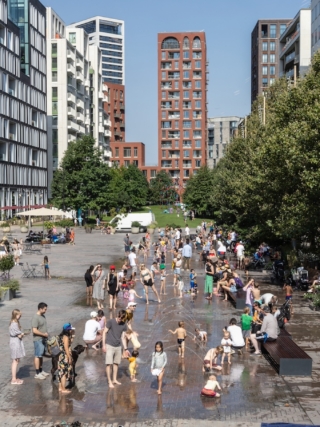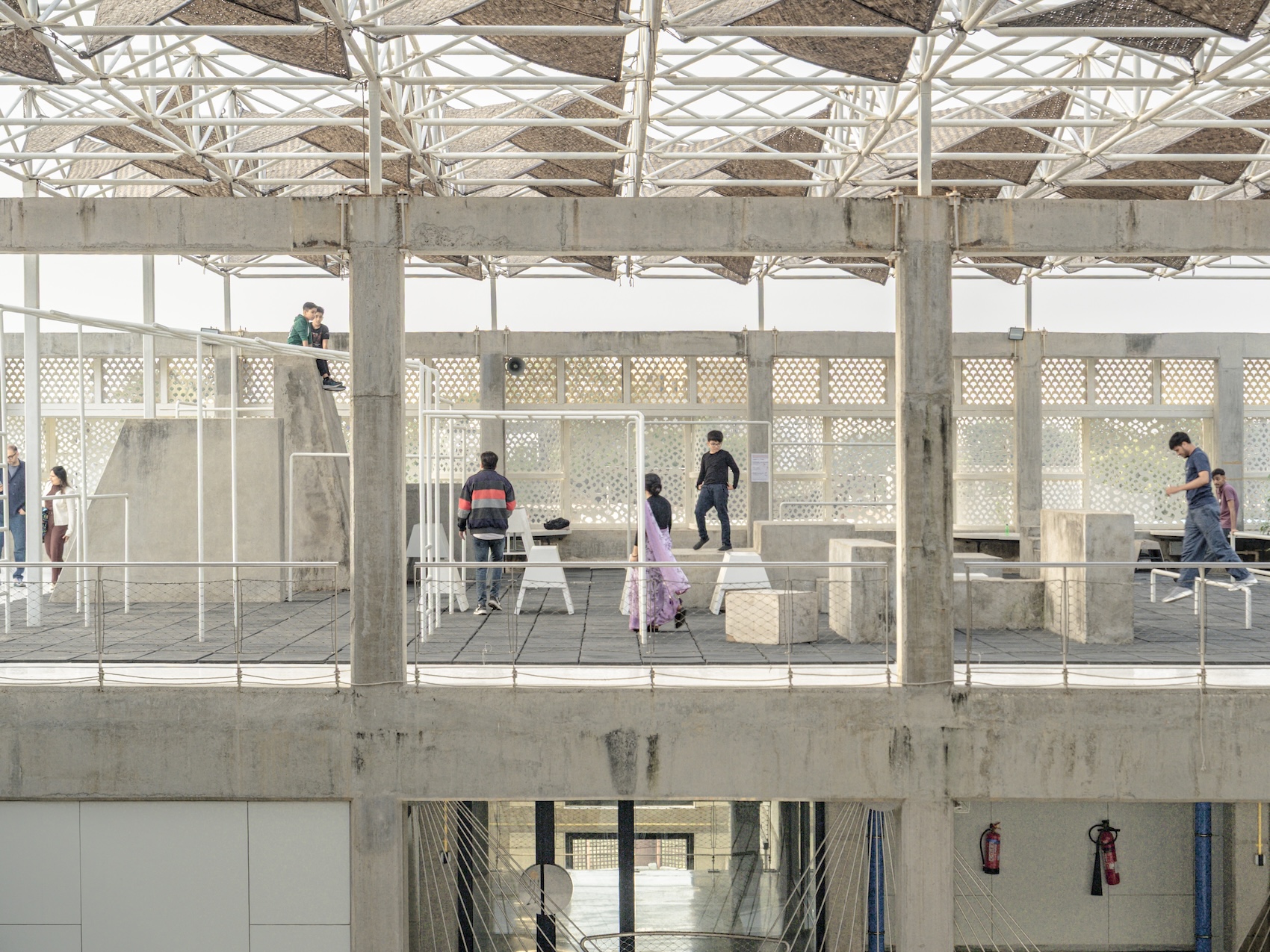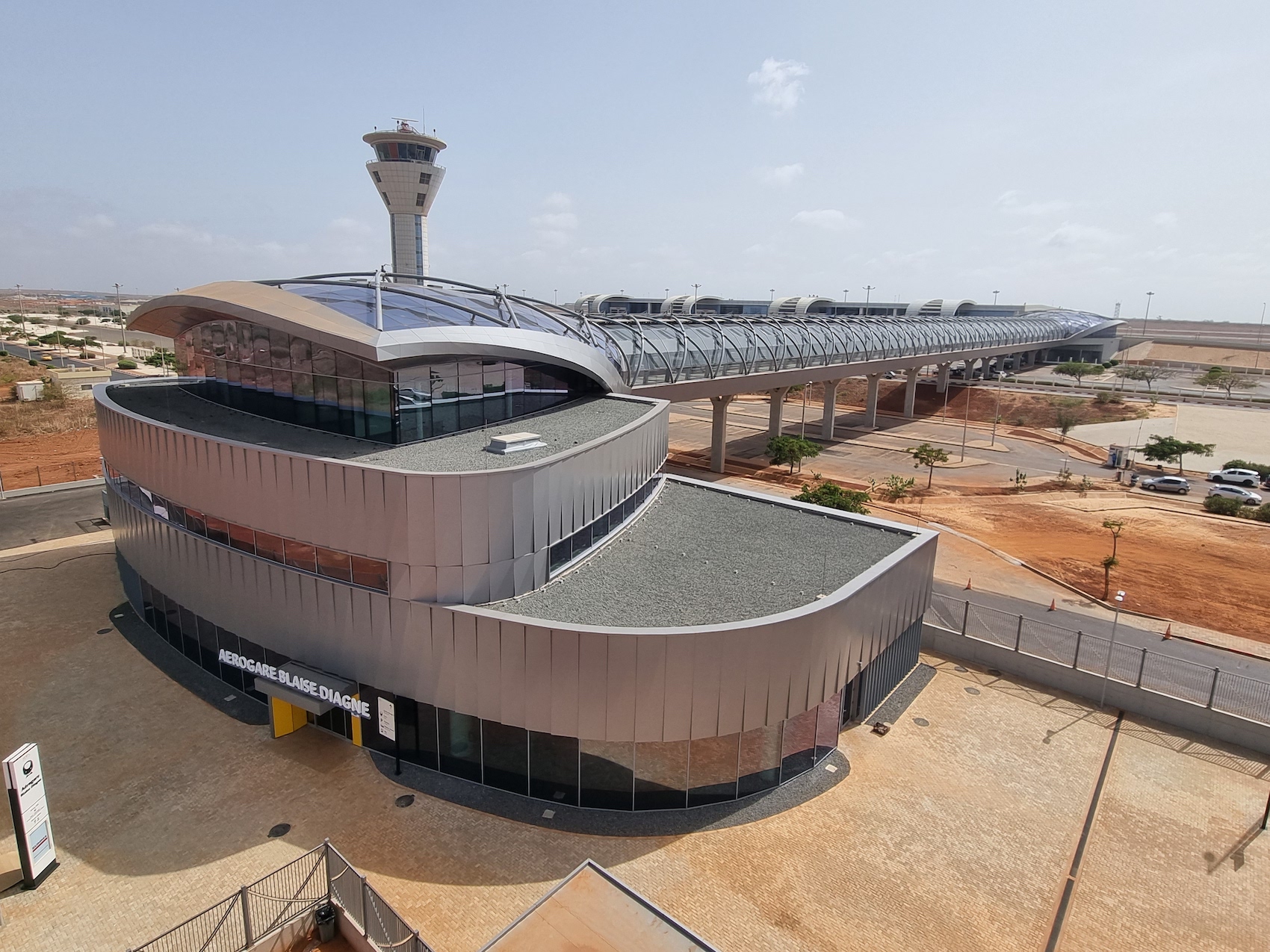Six projects from Allies and Morrison with Porphyrios Associates, Al-Jawad Pike, Clementine Blakemore Architects, Grimshaw, Jamie Fobert Architects with Purcell, and Mikhail Riches are in the running for this year’s Stirling Prize for the best new project in the UK.
King’s Cross Masterplan, London by Allies and Morrison and Porphyrios Associates. Credit: John Sturrock.
Varying in scale, six projects from across the country – albeit four being from London – are up for the 2024 RIBA Stirling Prize. This year sees a masterplan project included in the shortlist for the first time since 2009 when BDP’s Liverpool One Masterplan was in the running (losing out that year to RSHP’s Maggie’s West London Centre).
“These projects demonstrate the ingenuity and diversity of architecture today. From major national infrastructure to brave and brilliant council-led housing, these varied schemes are united in making sensitive contributions to elevating everyday life, said RIBA president Muyiwa Oki in a statement. “Whether raising the bar for social housing, upgrading city transportation or repurposing dilapidated buildings to create heritage-conscious urban and rural developments, each scheme thoughtfully adapts elements of our existing built environment.”
“At a time when the need to preserve our planet’s resources is greater than ever, these projects are to be commended for placing regeneration and restoration front and centre, transforming well and lesser-known landmarks to create highly sustainable places for future generations. This is purposeful yet unassuming architecture – architecture that brings joy to people’s lives and strengthens the fabric of our society.”
The winner will be announced London’s Roundhouse on 16 October 2024. Scroll down to learn about each of the shortlisted projects.
Photos by Rory Gardiner
Chowdry Walk by Al-Jawad Pike
London
Replacing an old parking lot in Hackney, London studio Al-Jawad Pike has designed 11 homes. Arranged in a staggered fashion and expressed in brick, the two storey development includes seven socially rentable homes and carves out a new cyclist and pedestrian route through the site. The layout of the terraces ensures the homes benefit from passive solar gain, while residents maintain privacy and avoid any overlooking from neighbours.
Jury citation:
Entrance porches are carved out of the plan with granite plinths and planters lining the building frontage. The elevations have a regular rhythm of openings, save for the ‘teacup’ feature window on the main street frontage, signalling this new and contemporary intervention. The overall material palette is constrained – red brick and granite. House numbers are elegantly set into bespoke precast panels.
The newly created route is cobbled with differing patterns demarcating uses. In the main thoroughfare, the cobbles are orthogonally laid, while those adjacent to the boundary wall fall into an arrangement of concentric pools laced with intermittent pockets of planting. These serve as rain gardens and are set within intermittent projecting buttresses along the length of the boundary wall.
The development has engaged with the issues of climate challenge in a positive way, clearly acknowledging all the requirements for both operational and embodied carbon. The homes are constructed in cross laminated timber (CLT), which is exposed internally in places. Windows are triple-glazed, and the houses have photovoltaics on their mono-pitched roofs. The scheme was well developed before 2019 when the RIBA 2030 Climate Challenge was issued, and utilises gas alongside on-site renewables for the energy strategy. As a result of a good fabric efficiency, residents have benefited from a significant improvement in actual versus predicted energy use.
Overall, Chowdhury Walk is an elegant piece of architectural and urban design, providing new homes that are successfully knit into their context – satisfying both resident and passer-by.
Photos by Hufton + Crow
The Elizabeth Line, by Grimshaw, Maynard, Equation and Atkins
London
Some 700,000 passengers use the Elizabeth Line every weekday, connecting people from the far reaches of London – and beyond. Knitting this route together aesthetically is a range of stations that employ a refined and considered palette of materials, lighting and signage to ensure a calm environment where passengers can interchange between the world’s oldest underground system and one of the newest.
Jury citation:
The project team was organised into ‘station’ and ‘line-wide’ teams. The line-wide team was responsible for overall experience in areas below ground, encompassing concourses, tunnels, and platform environments. The main works packages included tunnel linings, platform edge screens, signage and wayfinding, flooring, lighting, seating, poster frames, fire equipment cabinets, handrails and balustrades, and communication equipment integration.
The ethos behind the component design was to rationalise and refine. Stakeholders were involved from an early stage and full-size prototypes were produced for performance testing. Passenger tunnels are lined with spray-painted, glass-reinforced concrete panels that are curved at tunnel intersections to minimise blind spots and improve flow. Through collaboration, the team were able to reduce the number of different tunnel diameters and components and improve the efficiency and complexity of the design.
The passenger experience feels significantly different from other tube lines. The Elizabeth Line’s spaces are decluttered and calm, and the acoustics feel appropriately muted. The overall material palette is limited, with concrete-lined walls, and glass and stainless steel to the platform edge screens and technological totems. Grouping the technology has also rationalised servicing, maintenance, and replacement.
Passenger wayfinding is key to the experience. Information has been cleverly ordered. Waiting for the train, the directions are clearly displayed only on the platform edge screen. Stepping off the train, you will find the guidance you need on the back wall of the tunnel, facing you. There are no other display distractions here.
As a vast infrastructure project, the Elizabeth Line defies most of the current metrics of the RIBA 2030 Climate Challenge. The initial whole life carbon assessment revealed that a huge amount of carbon would be used in the creation of the tunnels. (Almost 100 per cent of excavated material was diverted from landfill and deposited at a nature reserve in Essex.) The 120 year lifespan of the project meant that much could be attributed to operational energy, far outweighing the embodied carbon created. This realigned the focus on the operation and maintenance of the scheme, with easily replaceable and accessible elements. Ultimately the team created their own benchmarks, which has resulted in this being one of the UK’s most sustainable infrastructure projects.
Photos by John Sturrock
King’s Cross Masterplan, by Allies and Morrison and Porphyrios Associates
London
Twenty years in the making, the King’s Cross redevelopment has seen what was once industrial wasteland be transformed into a thriving hub in London. With new streets, offices, schools, and restored historic buildings, the masterplan celebrates the area’s industrial heritage and uses existing building stock and infrastructure, such as the Regent’s Canal, to activate new space and link previously disconnected parts of the city together.
Jury citation:
Even though many of the jury knew the project personally, whether they had taken their young children to play in the Granary Square fountains or enjoyed restaurants or films there, the tour was eye-opening when experienced as a totality. The architects and client explained how, rather than imposing an urban geometry and building design codes, with which they were very familiar on other projects, they had simply asked that the architects of the individual buildings ‘respect’ each other. This straightforward inversion of responsibility makes all the difference in the quality of the buildings. Indeed, it flows from their original approach to the masterplan, where ‘found-ness’ is prized, the site’s history (coal drops, gasometers) celebrated and integrated, and there is a sense that its success is predicated on it almost disappearing into normality.
Two routes – King’s Boulevard and Pancras Square – lead north to cross the Regent’s Canal. The infilled canal basin of Cubitt’s Granary Building, now the Central Saint Martins art school, has become a lively public space. Twenty new streets and lanes, ten new open spaces, including five new squares with buildings by 30 architects, and 20 refurbished historic buildings and structures, including reclaimed gasometers, make up an appropriately scaled piece of London. There are two primary schools, more than 1,700 new homes, over four million square feet of office space, an art gallery, cinema, shops, centre for Islam, and of course the art college. More than 40 per cent of its 67 acres are open space, with over 600 plant species and 400 trees.
The developer client was able to set goals for all the buildings and spaces, with reduction of energy demand, use of a district energy centre, decarbonisation, and energy procurement goals all embedded in the design briefs. Ten of the new buildings are BREEAM Outstanding. Combined with the carbon savings through retention and renovation of the historic buildings, it all makes for a robust sustainability narrative.
King’s Cross Masterplan is a global exemplar in how to make a community of places which supports human activity, maintains an urban identity, and is supple enough to accommodate inevitable change.
Overall, Chowdhury Walk is an elegant piece of architectural and urban design, providing new homes that are successfully knit into their context – satisfying both resident and passer-by.
Photos by Olivier Hess
National Portrait Gallery, by Jamie Fobert Architects and Purcell
London
Now fully accessible to all, the National Portrait Gallery – a Grade I* listed cultural institution – has been delicately upgraded to be fit for the 21st Century. Old elements have been repurposed, with original windows forming new doorways. New elements have been integrated into the existing fabric, too, and the gallery has a new learning centre and a new entrance, being reorientated to open out onto the West End.
Jury citation:
The restoration effort aimed to restore clarity in the Gallery’s layout and reintroduce natural light into its galleries, breathing new life into the historic fabric of the space. The meticulous attention to detail in preserving original features and repairing historical elements ensures a harmonious integration of past and present.
Furthermore, the transformation extended to repurposing underutilised spaces, such as the Weston Wing, which has been converted from office spaces to house the contemporary collection. This adaptive reuse not only increases public space by approximately 20% but also enriches the visitor experience by providing new opportunities for engagement.
The learning centre under the new entrance bridge is a notable addition to the Gallery. Designed to offer improved learning experiences for visitors of all ages, this space represents a significant enhancement from previous facilities, providing a range of studios and a courtyard garden for educational activities.
Through a collaborative effort, the National Portrait Gallery transformation celebrates its rich heritage while embracing a vision for the future that is inclusive, engaging, and inspiring for generations to come. This revitalisation project reaffirms the Gallery’s position as a cultural landmark in the heart of London, poised to continue its legacy of storytelling and connection with the public.
Photos by Tim Crocker
Park Hill Phase 2, by Mikhail Riches
Sheffield
Giving Jack Lynn and Ivor Smith’s Brutalist landmark – Europe’s largest listed structure –a new lease of life, the second phase of this regeneration project has modernised existing homes with open plan designs, additional balconies and a fresh colour palette applied to the façade. Apartments are now more thermally efficient too, after thermal imaging revealed where significant improvements could be made throughout the structure.
Jury citation:
The first phase of the project stripped the building back to its frame and used bright colours to create a distinctly modern appearance. In contrast, Phase 2 is a ‘lighter touch’, retaining more of the existing built fabric and employing more subtle colours to blend the complex into the landscape. These colours, referencing the nearby Peak District, are used on the balcony reveals and flat entrances, giving each flat its own identity while keeping the character of the overall building.
The local Pennine landscape is also reflected in the planting around the complex. New trees and wildflower meadows combine with retained existing mature trees to create a biodiverse wildlife habitat on this previously grassed site.
With a brief to preserve as much of the original building as possible while making the flats more energy efficient and flexible, the architects collaborated closely with heritage experts. Using thermal imaging, problem areas were identified and solutions developed. As the size and layout of the existing flats did not meet modern standards and ways of living, they have been reconfigured to provide generous open-plan living spaces, orientated to take advantage of the best views across the city. The result is a variety of different flat types and that creates a mixed community and a place where both first-time buyers and families can live, work, and play.
The jury were particularly impressed by how the architects have overcome the many challenges of the 1950s structure and delivering a project during the Covid-19 pandemic. Project architect Alim Saleh, who was involved in the scheme from the early competitions stages, has been awarded RIBA Yorkshire Project Architect of the Year. Through his commitment and understanding of the building and its context, he developed a design that celebrates city centre living and respects the character of this important listed building.
Photos by Emma Lewis and Lorenzo Zandri
Wraxall Yard, by Clementine Blakemore Architects
Dorset
In West Dorset, Clementine Blakemore Architects has turned a series of derelict farmhouse buildings into a rural retreat for holidaymakers, a workshop and a centre for community activities. The previously ignored agricultural buildings are now all fully accessible and provide those who need assistance travelling with a high degree of independence.
Read about this project in further detail in AT’s coverage here.
Jury citation:
The buildings were dilapidated, so had to be partially rebuilt reusing existing stone, those roof trusses that were salvageable, and two thirds of the clay tiles. New materials such as the home-grown Douglas fir roof joists were locally sourced where possible. The architect worked closely with local craftsmen to achieve a high quality of finish with an appropriately rural feel to the detailing, so the agricultural buildings’ essential historical character was not washed away. While lip service is often paid to the local vernacular through form, here the vernacular’s full spirit is present through the craft in making, such as in the lime mortar stonework or the new Douglas fir screens.
You could spend a long time here and keep finding new things. The touch of the designer feels light, the changes between materials very natural, and the interfaces between buildings and landscaping well considered. Most of the internal spaces are open to the rafters, but there are subtle changes in scale: from the two-storey elevation facing the car park, through a tall breezeway entrance porch, into the more intimate courtyard bounded by single-storey holiday cottages. Inside, the cottages retain a rustic feel with exposed trusses and glossy concrete floors.
The client could easily have spent less, and the project shows an extraordinary level of ambition and commitment. It was driven partly by the fact that Wraxall Yard director Nick Read’s mother had multiple sclerosis (MS) and was always frustrated by the standard of holiday accommodation available to people in wheelchairs.
The project architect, Clementine Blakemore, has been awarded RIBA South West Project Architect of the Year. As Nick Read says, ‘It takes a special talent to master all the essential elements of being an architect; creative and technical design, project and contract management, steering a client through an unfamiliar process, and so on. Without doubt, Clem has achieved all this to an exceptional level. I doubt there is a more satisfied client than me, truly overwhelmed by the finished result, delivered without stress and on budget.













































